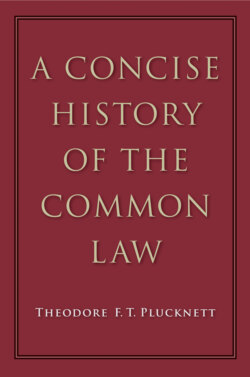Читать книгу A Concise History of the Common Law - Theodore F. T. Plucknett - Страница 150
На сайте Литреса книга снята с продажи.
THE NISI PRIUS SYSTEM
ОглавлениеAs for the Bench in the reign of King John, it was sufficiently important for the Charter to enact that it should no longer travel but sit permanently in some fixed place. This was perhaps convenient for suitors, but as the business of the court increased it was a grave hardship to bring jurors from the remoter parts of England to Westminster; indeed, in many cases it was utterly impossible. The solution of the problem was all the more difficult now that the Common Pleas (and for that matter, the Exchequer) were fixed at Westminster.1 The verbal altercation which resulted in the formulation of irrevocable pleadings had to take place (at this date) in court before the judges, who supervised the process and helped the parties to reach a suitable issue. Once the issue was reached, however, it was a simple business to put the issue to the jury and record their verdict. This second process, it was realised, need not take place at Westminster. As early as 1196 parties were given a day at Westminster “nisi justiciarii interim veniant” in Norfolk,2 and in the early years of Henry III justices in eyre would sometimes order juries to be taken locally (instead of before themselves) in order to save trouble to all concerned,3 and would likewise order the verdicts of locally taken inquests to be returned if necessary to Westminster.4 This separation of fact-finding from the rest of legal procedure gave the solution to the problem, and so legislation beginning with Edward I in the Statute of Westminster II, c. 30 (1285) slowly built up the system of nisi prius, whereby actions which began at Westminster in the Court of Common Pleas, when once they had been pleaded to an issue, could be continued by taking the jury’s verdict in the county before justices of nisi prius, instead of compelling the jurymen to undertake a costly journey to Westminster as had formerly been the case. The rise of this system had the result that a great deal of jury work took place in the country and not in Westminster; such proceedings were rarely reported, for the compilers of the Year Books were most concerned with what went on at Westminster Hall, and so the whole procedure of putting evidence before a jury, charging it and taking its verdict is an obscure matter, for neither the reporters nor the rolls give us very much information.5 Of these two sources the rolls are perhaps the more promising for the early history of the law of evidence.
The commissioners of assize need not be justices (although the ywere frequently serjeants, and local knights had to sit with them); the commissioners of nisi prius, on the other hand, had to be sworn justices. At the same time, it was a frequent practice to issue special commissions from time to time to justices and others authorising them to hear and determine (oyer and terminer) all pleas arising in a particular county, or all pleas of a particular type—sometimes to hear and determine one case of special importance. Furthermore, commissions of gaol delivery were a frequent necessity in order to try the persons indicted before various authorities. As a matter of obvious convenience these commissions were eventually issued to the same commissioners. Justices had to be sent at stated intervals to take nisi prius trials; the same justices could also take the assizes, and it was convenient to give them oyer and terminer and gaol delivery1 powers as well. Hence there arose the circuit system whereby the justices of the superior courts made regular tours of the country and thus brought the courts of Westminster into direct contact with local needs. To complete their powers, it was customary to make the judges of assize justices of the peace in the counties they visited.
